Regimental Coat for Enlisted Ranks
- 7thregimentoffoot

- Dec 19, 2020
- 3 min read
Updated: Dec 19, 2020
When recreating eighteenth-century British military clothing, it is important to keep in mind the three most important goals:
Fit
Fabric
Finish
Your first goal is to make sure that your clothing is made with the correct patterns, drafted off original clothing, and tailored to you by a professional tailor. This will ensure a correct eighteenth-century fit.

Next, you should use the most correct materials currently available. For a military impression this will include woolen broadcloth, kersey, bay or serge, natural gray linen, hemp Russia drilling, and white shirt linen.
Finally, your garments should be constructed using period techniques. All visible stitching must be done by hand, even on hard to notice items. While we encourage our members to construct their entire uniform by hand using linen thread, we are aware of the time and effort required to do this and its negligible payoff. Thus, we allow the use of a sewing machine to construct hidden seams.
Contact Carl Ivarson at Line of March for more information about fit, fabric, and finish. Click here for resources on where to purchase materials.
7th Regiment of Foot Regimental Coat Enlisted Ranks Instructions
BODY OF COAT

We currently use Madder red Kochan-Phillips broadcloth. This wool is manufactured in England and closely matches the color and hand of eighteenth-century military coating. We will continue to use this fabric until proper madder dyed cloth becomes available.
We utilize a single shoulder strap on the right shoulder to secure the cartridge pouch. It buttons at the collar with a single small 7th regimental button. The strap is sewn into the seam of the armhole. Be sure to tailor the arm’s eye so the sleeve-body seam is well up on top of your shoulder, and high and tight under the arm-pit.
FACINGS
British Royal Blue Kochan-Phillips broadcloth. Edges of lapel facings, collar, and turnbacks are to be left “raw”. Top stitching to be done with bleached white linen thread.
LINING OF TORSO
There is some speculation as to what the body of the coats would have been lined with. Current research indicates that most British regimentals were likely fully lined with natural white bay— plain weave, with a worsted warp and woolen weft. However, natural white serge is also known to have been used for lining, especially among more elite regiments such as those of the Brigade of Guards. There is speculation that the 7th, as a Royal Regiment, would have likely had serge as well. Thus, until further research can be conducted, we are allowing both Serge and Bay for linings.
Welted pockets are to be cut into the lining.
LINING OF SLEEVES
Unbleached linen, or, can be left unlined.
LACE

White worsted lace with a single blue stripe. These are to be formed into
the “reverse hammerhead” style that was peculiar to the 7th Regiment of Foot, as seen in the Lace Book. Although there is speculation that the 7th wore their lace in pairs, we will wear our lace evenly spaced until documentation from our time period suggests otherwise.
TURNBACKS
To be secured by brass or japanned brass hooks and eyes. No turnback ornaments, such as hearts, lace etc, shall be worn.
CUFFS
To be working cuffs and to be “round” (as opposed to slit or slashed)—3 1.2” wide
COAT IS LAPELLED TO THE 18TH CENTURY NATURAL WAIST
According to eighteenth-century tailor Matt Keagle: “The bottom of the lapels, top of horizontal pockets and side vent buttons and back vent should all line up (on the imaginary waist line). The waist on 1770’s coats is lower than many of us imagine falling slightly below the natural waist.”
SIDE VENTS

To be false and stitched down. One large regimental button at the top of each of the side vents.
CAPE (COLLAR)
Pointed at rear of collar. Collar edges to be left “raw”.
LARGE PEWTER REGIMENTAL COAT BUTTONS
When applied to the coat, buttons should be corded with linen or worsted tape, rather than simply being sewn down.
COAT POCKET FLAPS
To be horizontal and stitched down. 4 loopings of lace to be applied and 4 corded buttons.
HOOKS AND EYES
Two or three large brass or japanned hooks and eyes to close the front of the jacket. They are to be placed corresponding to the first and fourth lace loops, and they are to be set into the coat’s lining. A third may be placed equidistant from the top and bottom hooks, but is not necessary.
For more information about regimental uniforms contact Carl Ivarson at Line of March.


Comments